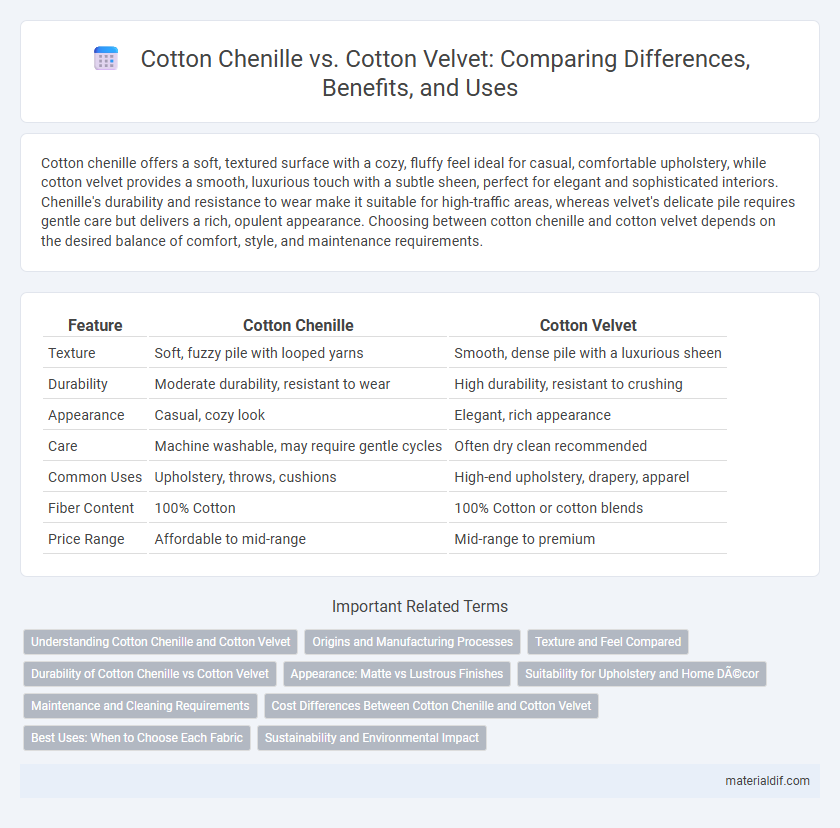Cotton chenille offers a soft, textured surface with a cozy, fluffy feel ideal for casual, comfortable upholstery, while cotton velvet provides a smooth, luxurious touch with a subtle sheen, perfect for elegant and sophisticated interiors. Chenille's durability and resistance to wear make it suitable for high-traffic areas, whereas velvet's delicate pile requires gentle care but delivers a rich, opulent appearance. Choosing between cotton chenille and cotton velvet depends on the desired balance of comfort, style, and maintenance requirements.
Table of Comparison
| Feature | Cotton Chenille | Cotton Velvet |
|---|---|---|
| Texture | Soft, fuzzy pile with looped yarns | Smooth, dense pile with a luxurious sheen |
| Durability | Moderate durability, resistant to wear | High durability, resistant to crushing |
| Appearance | Casual, cozy look | Elegant, rich appearance |
| Care | Machine washable, may require gentle cycles | Often dry clean recommended |
| Common Uses | Upholstery, throws, cushions | High-end upholstery, drapery, apparel |
| Fiber Content | 100% Cotton | 100% Cotton or cotton blends |
| Price Range | Affordable to mid-range | Mid-range to premium |
Understanding Cotton Chenille and Cotton Velvet
Cotton chenille features a unique pile yarn construction that creates a soft, fuzzy texture ideal for upholstery and cozy home textiles, while cotton velvet possesses a dense, smooth pile with a luxurious sheen perfect for high-end apparel and drapery. Both fabrics use cotton fibers but differ in weaving techniques; chenille employs tufted yarns to achieve its characteristic tufted surface, whereas velvet is woven with a cut pile that gives it its plush, glossy appearance. Understanding these differences helps in selecting the appropriate fabric based on durability, texture, and aesthetic appeal for specific textile applications.
Origins and Manufacturing Processes
Cotton chenille originates from the Arabic word "khanal," referring to its caterpillar-like yarn, and is made by weaving short lengths of yarn called "pile" between two core threads to create a fuzzy texture. Cotton velvet derives from the French word "velu," meaning hairy, and is produced through a weaving process that forms two layers of fabric simultaneously, which are then cut apart to create a plush pile surface. Both fabrics use cotton fibers but differ significantly in texture and production techniques, with chenille emphasizing softness and tufted loops, while velvet features a dense, smooth pile.
Texture and Feel Compared
Cotton chenille features a soft, tufted texture with a plush, caterpillar-like pile that creates a cozy and slightly fuzzy feel, making it ideal for upholstery and throws. In contrast, cotton velvet has a smooth, dense pile that offers a luxurious, silky touch with a subtle sheen, providing a rich and elegant appearance. The tactile difference lies in chenille's more textured and casual comfort versus velvet's sleek and refined softness.
Durability of Cotton Chenille vs Cotton Velvet
Cotton chenille features a tufted yarn structure that enhances its durability, making it resistant to wear and maintaining its texture after repeated use. Cotton velvet, while luxurious and soft, has a shorter pile that can flatten or show wear more quickly under heavy use. The dense fiber arrangement in cotton chenille provides greater longevity compared to the delicate, smooth surface of cotton velvet.
Appearance: Matte vs Lustrous Finishes
Cotton chenille features a matte finish with a soft, fuzzy texture that absorbs light, creating a cozy and muted appearance ideal for casual and rustic decor. Cotton velvet boasts a lustrous finish characterized by a smooth, dense pile that reflects light, giving it a rich, elegant sheen perfect for luxurious upholstery and drapery. The distinct surface qualities of chenille and velvet offer versatile visual impacts, with chenille's subtle warmth contrasting velvet's vibrant glow.
Suitability for Upholstery and Home Décor
Cotton chenille offers a soft texture with a plush pile, making it ideal for upholstery in high-traffic areas due to its durability and stain resistance. Cotton velvet provides a luxurious feel with a smooth, dense pile, suitable for elegant home decor but requires more careful maintenance to prevent wear and fading. Both fabrics enhance interior aesthetics, with chenille favoring practicality and velvet emphasizing sophistication.
Maintenance and Cleaning Requirements
Cotton chenille requires gentle cleaning methods such as vacuuming and spot cleaning with mild detergents to maintain its soft texture and prevent fiber damage. Cotton velvet demands careful dry cleaning or low-temperature machine washing to preserve its luxurious pile and color vibrancy without causing matting or shrinking. Both fabrics benefit from prompt stain treatment but differ in their tolerance for water and agitation during maintenance.
Cost Differences Between Cotton Chenille and Cotton Velvet
Cotton chenille typically costs less than cotton velvet due to its simpler weaving process and lower production expenses. The plush texture of chenille is achieved through tufted yarns, making it more affordable compared to velvet's dense pile created by weaving two layers of fabric together. Cotton velvet's intricate manufacturing and luxurious finish contribute to its higher price point, often making it a premium choice over cotton chenille.
Best Uses: When to Choose Each Fabric
Cotton chenille is ideal for upholstery and home decor due to its soft texture and durability, making it perfect for cushions and throws that require a cozy, inviting feel. Cotton velvet suits luxury garments and elegant drapery, offering a sumptuous sheen and smooth finish that enhances formal wear and sophisticated interiors. Choosing chenille optimizes comfort and resilience in everyday use, while velvet elevates style and opulence for special occasions.
Sustainability and Environmental Impact
Cotton chenille and cotton velvet differ significantly in sustainability and environmental impact; cotton chenille is often produced with less water and energy due to its simpler weaving process, while cotton velvet requires intensive processing and finishing treatments that increase resource consumption. Both fabrics rely on conventional cotton cultivation, which poses challenges such as high pesticide use and water-intensive farming, but organic cotton variants reduce these concerns substantially. Choosing sustainably sourced cotton and eco-friendly manufacturing certifications like GOTS helps minimize the environmental footprint of both cotton chenille and cotton velvet textiles.
Cotton Chenille vs Cotton Velvet Infographic

 materialdif.com
materialdif.com